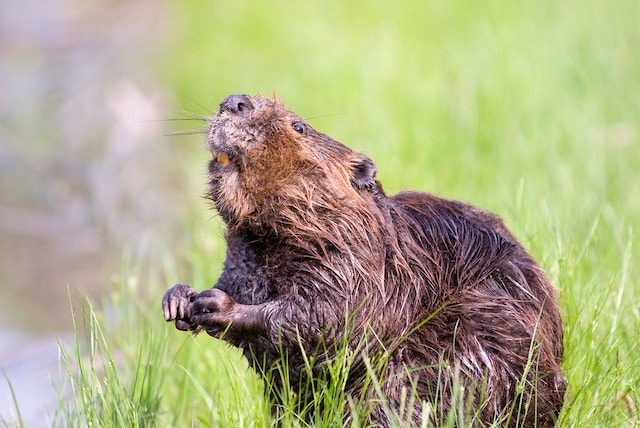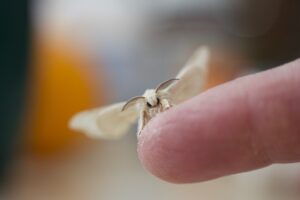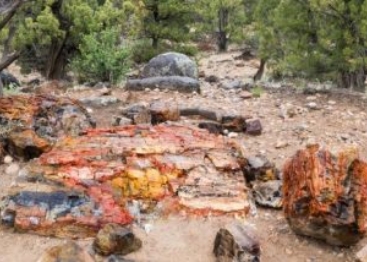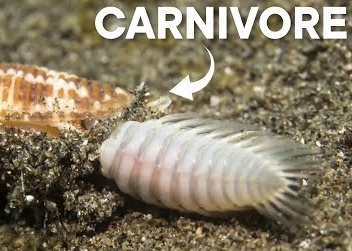10 Spine-Chilling Water Worms Found in Lakes and Oceans
The ocean is full of surprises, and some of its most bizarre inhabitants are marine worms that seem to have crawled straight out of a sci-fi movie. These slimy, toothy creatures are not only strange to look at but can also be surprisingly dangerous. Imagine a worm with rows of sharp teeth, gliding through the water with an almost alien-like grace. Sounds like something from a horror film, right? Well, these worms are very real, and they’re out there, thriving in the depths of the ocean.
What makes these worms so fascinating is their combination of traits that seem almost too weird to be true. They’re slimy, which makes them slippery and hard to catch, and their “toothy” mouths are perfectly designed for chomping through their prey. Some species even have jaws strong enough to break through shells, making them formidable predators in their underwater world. It’s like nature decided to mix the creepiest features into one creature, just to keep us on our toes.
But it’s not all about their scary appearance. These worms play a crucial role in the ocean’s ecosystem. They help break down organic matter, recycle nutrients, and even serve as food for larger marine animals. So, while they might look like something from a nightmare, they’re actually an important part of the underwater food chain.
If you’ve ever wondered what it would be like to encounter a creature that blurs the line between reality and fiction, marine worms are a perfect example. They’re a reminder that the ocean is still full of mysteries, and some of them are as strange as they are fascinating. Whether you find them terrifying or intriguing, there’s no denying that these worms are one of the ocean’s most incredible oddities.
10.The Bootlace Worm
Ever wondered just how long a worm can grow? Well, if you’re ever tying your shoelaces at the beach, you might want to think about the Bootlace Worm (Lineus longissimus). This incredible creature doesn’t just hold the title of the longest worm on Earth—it’s the longest animal, period. Stretching up to a mind-blowing 180 feet, it’s like a living piece of rope that could easily dwarf a blue whale in length. But being the longest isn’t the only thing that makes this worm a record-breaker. It’s also packed with a surprising punch: it’s highly poisonous.
The Bootlace Worm’s slimy mucus isn’t just there to make it slippery. It’s loaded with a potent toxin that can immobilize its prey. Researchers, including Professor Ulf Göransson and his team at Uppsala University in Sweden, discovered that this mucus contains a peptide-based compound. While similar toxins are found in tropical cone shells, the Bootlace Worm brings this deadly chemistry to the cold waters off the coasts of Europe. Imagine a creature thriving in chilly seas, armed with a chemical weapon that can take down crustaceans and insects in seconds.
What’s even more fascinating is how the Bootlace Worm uses its poison. Unlike venomous animals that inject toxins to hunt, this worm relies on its mucus to do the job. Typically, poisonous creatures use toxins as a defense mechanism to avoid being eaten. But the Bootlace Worm flips the script, using its toxic slime to catch prey instead. It’s a rare and intriguing example of how nature can blur the lines between predator and defender.
So, the next time you’re at the beach, take a moment to appreciate the weird and wonderful world beneath the waves. The Bootlace Worm is a perfect example of how the ocean continues to surprise us with its bizarre and sometimes terrifying inhabitants. Whether you find it fascinating or a little creepy, there’s no denying that this worm is one of the most extraordinary creatures on the planet.
9.Osedax Worms
Ocean-going killers of cetaceans such as large sharks and Orcas might have some little accomplices in the form of worms that take care of the evidence. What happens to whale bones when they sink to the bottom of the sea? Why might it be hard to find many whale skeletons? They get eaten. Little marine worms called Osedax crave bone minerals and actually feed on the bones of whales. Nature lets nearly nothing go to waste and bone-eating seems to be working well for these creatures.
The so-called “Zombie worms” are a fairly new discovery, first observed in 2002 in the wild thanks to advances in deep-sea exploration before being scientifically described in the lab in 2004. The worms were discovered at a depth of 10,000 feet feeding in a grey whale skeleton. Crazier yet, these creatures lack a stomach or a mouth. Osadex worms just secrete acid that melts bone, releasing meat-like nutrients for the worms to take up through the work of symbiotic bacteria that proceed to break down the actual nutrients. Only females do the acid drilling, while males live inside the females as microscopic organisms. Would the worms eat a dead human? Pretty likely, since they have fed on cow bones at sea…
8.Piling Worm
When the lunar signals are right, huge marine worms common in the Pacific Northwest called Giant piling worms, grow up to a foot-long swarm to the surface and mate. The majority of the time, the creatures stay hidden in the sand, collecting food with their pincer-like jaws. Imagine swimming at night and being surrounded by foot-long marine worms. No thanks.
The marine pile worm species was identified as Nereis brandti, a type of polychaete worm, according to Louise Page, a biologist from the University of Victoria in BC, Canada. Page listed sand-dwelling habits as the typical behavior of the worms outside of mating season. The enormous size of the worms is off-putting to would-be adventurers, and reinforced by the presence of jaws which could deliver a painful bite thanks to the sharp appendages around the mouth. The swarming behavior gives rise to the fertilization of eggs and the appearance of tiny larval worms. Upon maturation, the worms may seem scary, but are actually most focused on eating algae. Their jaws are usually used to defend territory but offer only limited protection when the worms swim through the water, vulnerable to countless larger hunters.
7.Antarctic Scale Worm
The Antarctic scale worm, Eulagisca gigantea, is a creature that seems to have jumped straight out of a sci-fi horror movie. Covered in bristles and equipped with jaw-like structures that resemble something from “Tremors,” this stubby, fearsome-looking marine worm is not just a visual nightmare but also a formidable predator. Growing up to eight inches long, its scaly body blends seamlessly with the ocean floor, providing perfect camouflage. But don’t be fooled by its unassuming appearance—when it’s time to hunt, this worm reveals its secret weapon: a proboscis that looks like a head armed with massive, tooth-like structures. These jaws are not just for show; they’re a highly efficient tool for tearing into prey, making this worm a master of underwater ambush.
What’s even more fascinating is how the worm can retract its terrifying jaws back into its body when not in use, only to shoot them out again when an opportunity arises. While these “teeth” aren’t true teeth (since the worm is an invertebrate), they’re eerily similar to the fangs of a wolf, giving this marine creature an almost otherworldly edge. And yet, despite its monstrous appearance, there’s a strange beauty to it. Its body is covered in shiny, golden bristles that glimmer in the dark depths, creating a striking contrast to its otherwise horrifying features.
This worm is a true survivor, thriving in the icy waters of the Antarctic and diving to depths of over 1,600 feet. Its Latin name, gigantea, hints at its impressive size and strength, making it a heavyweight in its underwater domain. Whether it’s ripping apart prey or blending into the seafloor, the Antarctic scale worm is a perfect example of nature’s ability to create creatures that are both fascinating and terrifying. It’s a reminder that even in the most remote corners of the planet, life finds a way to adapt—and sometimes, that adaptation is as bizarre as it is awe-inspiring.
6.Fat Innkeeper Worm
Known in common language as the Fat Innkeeper Worm, Urechis unicinctus is an awful-looking creature, often compared to a penis in appearance. Yet its activities provide valuable habitat for a wide range of marine life that take refuge in the burrows they create. The bizarre worm is huge, bulbous, and beige and is named due to both its looks and the habit of creating horseshoe-shaped burrows that serve as invaluable “inns” for a vast range of intertidal creatures. Gobies, other worm varieties, and even small crabs use the burrows, without harming or helping the fat innkeeper worm itself. The creature is a denizen of estuarine, brackish waters, and mudflats, hanging out around coastal wetlands that are unfortunately extremely vulnerable to climate change and development-based disruptions.
The fat innkeeper worm feeds on plankton and is well known from the coast of California. Belonging to the phylum Echiura, the creatures may reach seven inches in length, large enough to startle beachgoers should be encounter one for the first time. In addition to maintaining “inns” for small creatures, the worms themselves are a veritable buffet course for larger visitors to wetlands, including bat rays, which suck up the worms, and opportunistic otters.
5.Multi-Butt Worm
No ifs or maybes, but plenty of but(t)s? Yes indeed. There is a marine worm with one head and well over 100 derrieres, according to recent findings. The annelid worm species Ramisyllis multicaudata is distantly related to the familiar earthworm but inhabits oceans instead of gardens and lives in sea sponges that serve as hosts. Research published in the Journal of Morphology describes how the worms use the hollowed-out interiors of marine sponges, an even simpler life form as a place of residence. How the worms feed is a matter of further research interest, given the lack of digested food found in the digestive tracts of the marine worms upon examination.
What is well documented is the importance of the many butts of the worms in reproduction, but not in the way you might expect. Each worm butt actually breaks away eventually and develops eyes and a brain before developing into a brand new worm that starts the life cycle over again. In extreme cases, the number of rears on a Ramisyllis multicaudata worm could be far more than reasonable imaginable. Up to 1,000 rear ends may be part of one worm.
4.The Burning Worm
Danger often comes in small bundles and that is the case with certain marine worms. While they only grow up to be about three to four inches in length, the worm community’s answer to the lionfish, scorpion, and stinging nettle is nothing to mess with. Found in warm tropical waters, Bearded fireworms Hermodice carunculata are covered in horrifying bristles that unload venom onto anyone or anything unlucky enough to touch them. Ouch! These toxic sea creatures are associated with Western and limited central Atlantic habitats that include coral reefs, under rocks, and even nestled in flotsam and jetsam drifting along the waves at sea.
The awful bristles are shiny and beautiful, having a resplendent appearance similar to a lionfish or sea anemone. The worm’s hollowed-out bristles effortlessly slide into the flesh of any creature that comes into contact with them and snap away, leaving bristles embedded. This causes mechanical and chemical irritation akin to being stung by a bee. To be fair, the worms do give out a warning first if bothered by first flaring out their bristles. Clearly, one of the laws of the sea to remember at all times is when in doubt, do not touch!
3.Parchment Worm
Looking like a literal paper dragon, the parchment worm Chaetopterus variopedatus constructs its burrow out of an extension of its body. While fragile, it is a strange mix of graceful and absolutely grotesque. The creature is gentle and feeds on plankton that it traps, and is not an aggressive hunter like many of the tougher worms in this account. Growing to about 10 inches in length, the worm is a bizarre but successful animal as a globally distributed generalist found in both tropical and cooler waters.
The feeding strategy of the parchment worm is decidedly odd. The worm’s body is formed by three sections, which include mouth and bristly body segments. Next, there is a structure that forms mucous and secreted mud-based bags in the center, with segments that pump water into the body tube. Finally, a third section made up of many segments in a row concludes the body plan. The remarkably mechanical animals simply bag up food filtered from the water in mucous and mud “capsules” and swallow them like pellets for digestion.
2.Spaghetti Worm
If you dumped a bowl of noodles on the seafloor, you would have a crazy-looking creature that looks exactly like either spaghetti come to life, or even a crawling mop head. All you see are the tentacle-like extensions as the worm winds along the seabed in search of meals. Unlike many marine worms, the spaghetti worm spends its life in the open, not needing the protection of a burrow. The creature is still in the process of being given a species name.
The discovery of the creature is fairly new, with the first sighting and description taking place during a research trip in the Gulf of California by the Monterey Bay Aquarium Research Institute (MBARI). This “dancing mop” may look vulnerable but apparently, the array of appendages allows the worm to collect small food items, all without having any eyes! The worm is a type of polychaete marine worm and belongs to the genus Biremis. Given the importance of polychaete worms in the marine environment, there is a World Polychaete Day which is July 1st to celebrate their existence. Footage of the mysterious Biremis species was first released on July 1st, 2012, nine years after its discovery by MBARI researchers to mark the special day.
1.The Bobbit Worm
Imagine a creature lurking beneath the ocean floor, waiting to ambush its prey with lightning speed and razor-sharp precision. Meet the Bobbit Worm, Eunice aphroditois, a nightmarish predator that could easily star in a deep-sea horror film. Armed with massive, fang-like pincers, this worm doesn’t just grab its prey—it can slice fish clean in half, even cutting through their spines with terrifying ease. And if that’s not enough to send shivers down your spine, its body is covered in stinging bristles that add another layer of danger to this already fearsome creature.
What makes the Bobbit Worm even more unsettling is its ability to strike with the speed and force of a viper. Its bite is so powerful and sudden that encountering one has been compared to accidentally triggering an underwater mine. But the danger doesn’t stop there. Those bristles aren’t just for show—they’re toxic and can cause long-term nerve damage if the worm is handled carelessly. This isn’t just a creature to admire from afar; it demands respect and caution.
Despite its drab, segmented body, the Bobbit Worm has an unexpected touch of beauty. Iridescent highlights shimmer along its length, adding a strange allure to its otherwise grotesque appearance. It’s a bizarre mix of ugly and mesmerizing, a reminder that nature often blends the beautiful with the terrifying.
And then there’s its size. While most Bobbit Worms grow to a few feet long, some can reach a staggering 10 feet in length and weigh up to a pound. But here’s the unsettling part: there could be even larger, more vicious specimens hiding in the depths, waiting to be discovered. This worm isn’t just a predator; it’s a symbol of the ocean’s mysteries and the unknown horrors that might still be lurking in its darkest corners.
The Bobbit Worm is a perfect example of how the natural world can be both fascinating and horrifying. It’s a creature that reminds us to approach the ocean with awe—and maybe a little fear. After all, in the deep sea, you never know what might be waiting to strike.
























